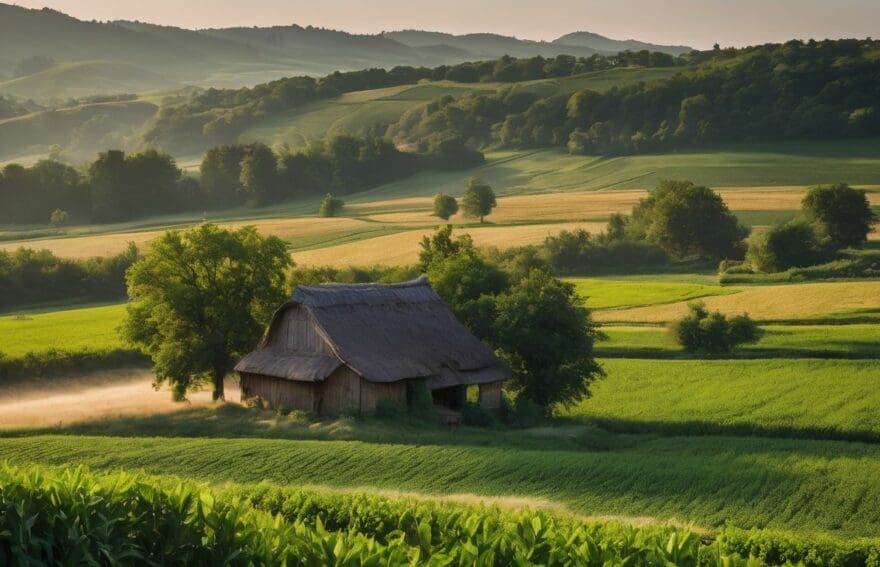Stardew Valley Farming Guide: Crops, Profits, and Seasons

Updated On: November 26, 2025 by James Connolly
Deciding which crops to plant with each turning of the seasons in Stardew Valley really can muddle one’s noggin. You’re not alone; it’s something we’ve all wrestled with, which is exactly why I took it upon myself to thoroughly investigate the ins and outs of agricultural triumphs in Pelican Town.
Within these lines, you’ll find a bespoke guide teeming with sage advice on picking and nurturing the most lucrative harvests as the year unfolds. Together, let’s transform those pastoral aspirations into bountiful riches!
Overview of Crops in Stardew Valley
In the verdant fields of Stardew Valley, we green-fingered enthusiasts are blessed with an array of crops that each sing the tune of their respective seasons. As spring unfurls its tender shoots, we eagerly anticipate post-Egg Festival days where strawberries offer a sweet hint of profit.
Then comes the summer sun, ripening blueberries and coaxing the tangled hops to reach for the sky.
As autumn’s palette paints our farms in russets and golds, cranberries and pumpkins swell with the promise of rich rewards. This isn’t merely farming; it’s nurturing a living tapestry under our watchful gaze.
Each seed sown requires our careful contemplation: from sprout to harvest, growth cycles test our resolve while market prices tap into our shrewd nature. The alterations ushered in with update 1.1 have seen us revisit old methods and embrace new techniques in pursuit of a more prosperous yield.
Let us now immerse ourselves in perfecting this craft as we unearth guidance on elevating those profits through selecting the most advantageous crops for each changing season—because here in Stardew Valley, tending to these fields is much more than routine; it’s about fostering life itself amidst a community woven from shared endeavour and rural charm.
Most Profitable Crops for Each Season
– Spring brings in the most profits with Strawberries, while Blueberries and Hops are the go-to crops for Summer. Finally, Cranberries and Pumpkins reign supreme during the Autumn season.
Each of these crops has a specific growth time, sell price, and profit per day that you need to consider before planting them on your farm in Stardew Valley.
Spring: Strawberries
Strawberries are the most profitable crop available to players during Spring in Stardew Valley. With a shorter growth time than most other crops, they provide high earnings and can be sold for a good profit.
Players can purchase strawberry seeds at the Egg Festival for 100 coins each or receive them as a reward from various sources, making them an attractive option for maximising profits.
By strategically planting and harvesting strawberries throughout the season, players can significantly boost their income and progress further in the game.
The profitability of strawberries makes them an excellent choice for both passionate gamers and novices alike. Their ease of cultivation, quick growth cycle, and high selling price make them an essential part of any player’s farming strategy in Stardew Valley.
Summer: Blueberries or Hops
Blueberries and hops are the top contenders for profitable crops during the summer season in Stardew Valley. Blueberries, once fully grown, produce multiple berries every few days, making them a highly lucrative choice for farmers.
On the other hand, hops can be turned into pale ale using kegs and provide a substantial profit margin when processed. With their respective advantages, both blueberries and hops offer great potential for maximising profits during the summer months.
Maximising profits from blueberries or hops requires strategic planning and consideration of factors such as crop growth times, sell prices, and overall profit per day. By taking advantage of these two high-yielding options, players can ensure a bountiful harvest while also securing significant returns on their farming investments in Stardew Valley.
Autumn: Cranberries or Pumpkins
After reaping the bountiful harvest of blueberries or hops in summer, autumn presents farmers with a choice between cranberries and pumpkins. These two crops offer different advantages – while cranberries provide a steady income through their multiple harvests, pumpkins yield higher profits with their high sell prices.
By strategically choosing between the two, players can maximise their earnings as they tend to their virtual farm in Stardew Valley.
At this point in the game, it’s crucial for players to consider factors such as crop growth times and sell prices when deciding which crop to cultivate. Both cranberries and pumpkins are excellent choices for autumn planting but weighing these factors against each other will help gamers make an informed decision.
Other Considerations for Choosing Crops
Consider the growth times, sell prices, and profit per day when choosing crops for your farm. Find out how these factors can affect your farming strategy and profits in Stardew Valley! Read more to learn about maximising profits as a farmer.
Crop growth times
Crops in Stardew Valley have varying growth times, ranging from a few days to a couple of weeks. Understanding these growth times is crucial for planning and maximising your harvest.
For instance, quick-growing crops like radishes can be harvested multiple times in one season, allowing for repeated profits. On the other hand, slower-growing crops like melons require more patience but yield substantial returns when ready for harvest.
Knowing the growth time of each crop also helps players strategise their planting schedule and ensure a steady flow of income throughout the seasons. This information plays a vital role in deciding which crops to prioritise and when to expect profits, contributing significantly to effective farm management and profitability.
Sell prices
After considering the crop growth times, it’s essential to take into account the sell prices. Knowing the varying prices for different crop qualities is crucial in making profitable decisions.
Understanding the fluctuation in prices for each season, along with their corresponding grow times, allows players to strategise and optimise their profits efficiently. By being aware of where to buy seeds, their costs, and how long they take to mature, gamers can make informed choices about which crops will yield high returns.
To maximise profits while farming in Stardew Valley, it’s important to keep an eye on fluctuations in crop quality prices and growth times. This knowledge helps players choose the most lucrative crops for each season wisely.
Profit per day
To maximise profits in Stardew Valley, it’s essential to consider the profit per day for each crop. By calculating a crop’s sell price minus the seed cost and dividing that by the number of days it takes to grow, players can determine which crops bring in the most income on a daily basis.
This information is crucial for optimising farm layouts and ensuring a steady stream of earnings throughout each season. Additionally, focusing on high-profit-per-day crops allows players to make strategic decisions about where to invest their time and resources.
For passionate and novice gamers alike, understanding the concept of profit per day is key to succeeding as a farmer in Stardew Valley. With this knowledge, players can make informed choices about which crops to prioritise based on their profitability over time.
Changes in Stardew Valley 1.1
In Stardew Valley 1.1, there have been significant changes to the crop regrowth system. This update introduced a new feature where crops can now regrow after being harvested, extending their productivity for additional harvests.
With this change, players can now enjoy increased profits over time by continually harvesting crops in the same plot of land.
Furthermore, another notable change in Stardew Valley 1.1 is the addition of new crop varieties and seeds available for purchase from in-game vendors. These new options provide players with more diverse choices when planning their farming strategies and aiming for maximum profitability throughout the seasons.
Maximising Profits as a Farmer
To maximise profits as a farmer, planting crops that span multiple seasons and taking advantage of the Greenhouse can help to ensure a steady income. Additionally, utilising crop regrowth can also help to increase overall profitability on your farm.
Planting crops in multiple seasons
To maximise our farm’s profitability in Stardew Valley, we should plant crops that span across multiple seasons. This strategy allows for a continuous harvest and income throughout the year.
By diversifying our crops to include those from different seasons, we can ensure a steady stream of earnings without having to wait for an entire season cycle before selling our produce.
Players can strategically select crops with varying growth periods, allowing for staggered planting and harvesting. Additionally, by leveraging the Greenhouse, we can extend growing seasons for certain crops or even cultivate non-seasonal plants all year round.
Utilising the Greenhouse
To maximise profits, we utilise the greenhouse to grow high-profit crops throughout all seasons. Crop regrowth is a key benefit of the greenhouse, allowing for continuous harvesting, and providing a steady income stream year-round.
With careful planning and strategic crop selection, we can cultivate valuable produce regardless of the season or weather conditions.
Understanding the benefits of utilising the greenhouse allows us to make informed planting decisions. It presents an opportunity to generate consistent revenue and optimises our farming strategy for long-term success.
Taking advantage of crop regrowth
To maximise profits, take advantage of crop regrowth in Stardew Valley. After harvesting a crop, some plants have the ability to grow back and produce additional yields without needing to replant seeds.
This feature allows players to continuously harvest crops throughout the season, increasing their overall profits. By strategically choosing crops that have regrowth capabilities, farmers can ensure a steady stream of income while minimising the need for additional resources and time.
Players should consider crops like blueberries and cranberries which have multiple harvests per season. These high-yielding plants provide an opportunity for continuous profit without the hassle of reseeding after each harvest.
Conclusion
In summary, Stardew Valley offers a variety of profitable crops for each season. Players can maximise their profits by considering crop growth times and sell prices. With the right farming strategy, utilising the greenhouse and taking advantage of crop regrowth can lead to significant earnings.
By planting crops in multiple seasons, players can ensure a steady stream of income throughout the year.
FAQs
1. What is the Stardew Valley Farming Guide all about?
The Stardew Valley Farming Guide provides planting strategy tips, seasonal crop rotation advice, and techniques for profitable harvests in the game.
2. How can I make my farm in Stardew Valley more profitable?
Maximise your profits by following agriculture guides for the best crops per season and implementing effective farming techniques to boost your yield.
3. Why is crop rotation important in Stardew Valley?
Crop rotation is key because it helps maintain soil health and increases farming profitability with different plantation cycles throughout the seasons.
4. When should I plant different crops during each season in Stardew Valley?
To get the most out of your garden, consult an agricultural guide that details which crops thrive best during specific seasons for strategic cultivation.
5. Can this guide teach me harvesting techniques to improve my farm’s output?
Yes, this guide includes farming tips on harvesting techniques tailored towards increasing efficiency and ensuring a successful agricultural venture in every season.


